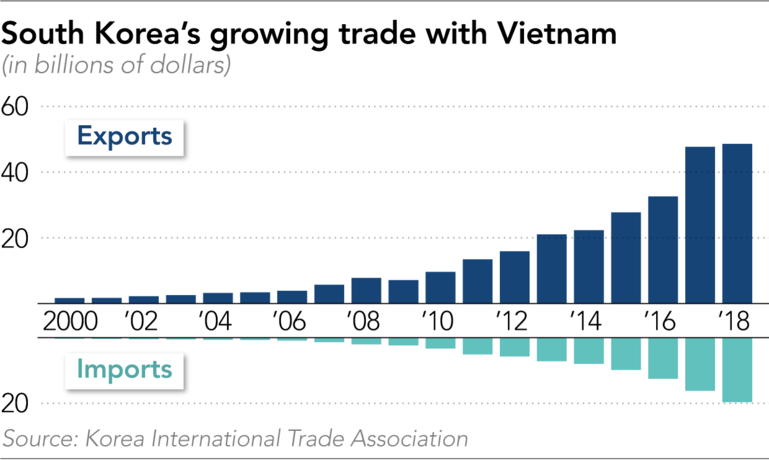 |
The net interest margin of banks in Vietnam, a key indicator of profitability, was about twice that of lenders in South Korea in 2017 -- 2.9% versus 1.63%, according to Vietnamese research firm Biinform and Seoul's Financial Supervisory Service, reported Asian Nikkei Review.
Shinhan Bank is the biggest foreign lender in Vietnam with US$3.7 billion in assets, though it is still small compared with Saigon Commercial Joint Stock Bank, Vietnam's largest private bank, which had US$18.2 billion as of the first quarter of 2019.
Shinhan showed its commitment in 2017 when it acquired Australia and New Zealand Banking Group's Vietnam retail unit.
Lee said western banks are leaving Vietnam because they focus on corporate and investment banking, but South Korean banks like Shinhan are betting on growth in retail banking, adding the bank grew explosively last year, creating enormous synergy effects.
Vietnam’s top source of FDI
 |
South Korean President Moon Jae-in previously said he is looking to boost ties with Vietnam and the broader ASEAN bloc under his "New Southern Policy," which seeks more well-rounded diplomatic ties beyond the US, China, Japan and Russia.
Bilateral trade between Vietnam and South Korea has exploded 34-fold since 2000. Ties between the countries have blossomed to the extent that Vietnam was South Korea's No. 3 export destination for the second straight year in 2018, after only China and the US, according to data from the Korea International Trade Association. It is expected to top the US in 2020.
South Korea in 2014 surpassed Japan as the top source of accumulated foreign direct investment in Vietnam -- a position it has not relinquished since.
Much of this is thanks to South Korean manufacturers like Samsung Electronics and LG Electronics. Samsung has invested about US$9.5 billion in the country since 2007, producing over 150 million smartphones at its factories in the provinces of Bac Ninh and Thai Nguyen, north of Hanoi.
LG makes appliances in Hai Phong, a two-hour drive east of the capital. The company announced in late April that it would transfer its smartphone production lines from Pyeongtaek, outside of Seoul, to Hai Phong later this year, increasing its annual Vietnamese smartphone production to 11 million units.
Phones have been Vietnam's top export since 2013. More importantly, South Korean investment has spawned a manufacturing ecosystem that promises to fuel the Vietnamese economy for years to come.
"There were around 7,000 Korean firms operating in Vietnam, providing jobs for more than 700,000 workers and contributing around 30% to Vietnam's export value," Vu Ba Phu, director of the Vietnam Trade Promotion Agency, said at an investment promotion conference in Hanoi in late April. South Korean companies, he stressed, have "also helped promote the development of Vietnam's supporting industry."
Samsung did business with 35 "tier 1" local suppliers in 2018, up from just four in 2014. This year it is sourcing from 42, and the number is expected to rise to 50 in 2020. The suppliers, in turn, are branching out into other industries like automobiles, armed with know-how gleaned from working with Samsung.
Preferred destination against China
 |
For South Korean companies, which rushed to cash in on China's huge market and inexpensive labor in the 2000s, Vietnam offers even lower costs and ostensibly less political risk.
The average Vietnamese manufacturing worker earned US$3,812 last year, about a third of China's average of US$10,520, according to the Hyundai Research Institute. And since Beijing clamped down on Korean companies over Seoul's deployment of a US missile defense system, more are heading for Vietnam instead.
Few companies were hit harder by the defense dispute than Lotte, which agreed in 2016 to provide land for the anti-missile system -- part of a golf course in Seongju. The Chinese government later appeared to punish the company, over alleged fire safety violations and other issues, prompting it to sell most of the 99 Lotte Mart discount stores in China.
Now, there are 14 Lotte Marts in Vietnam, one of which is inside the 65-story Lotte Hanoi Center, which also houses a department store and hotel.
Lotte is investing heavily in Ho Chi Minh City and Hanoi. It had poured in US$1.5 billion by 2016, and intends to spend an additional US$1 billion by 2024.
The Vietnam-South Korea relationship is not a one-way street. The Vietnamese government has loosened regulations on foreign business ownership, opening the door for more Korean companies. A research affiliate of Vingroup -- one of Vietnam's largest conglomerates -- opened an R&D center in the South Korean city of Daegu in March. Hanoitimes
Hai Yen
 Vietnam now is considered new growth engine for South Korea, because South Korean companies cannot expect much profitability in their home country, said Lee Sang-hon, director at South Korea’s Shinhan Bank.
Vietnam now is considered new growth engine for South Korea, because South Korean companies cannot expect much profitability in their home country, said Lee Sang-hon, director at South Korea’s Shinhan Bank.